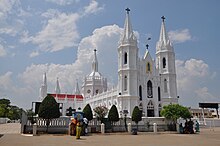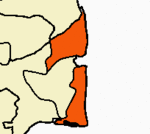
A shrine to the Virgin Mary, or Marian shrine, is a shrine marking an apparition or other miracle ascribed to the Blessed Virgin Mary, or a site on which is centered a historically strong Marian devotion. Such locales are often the destinations of Christian pilgrimages.
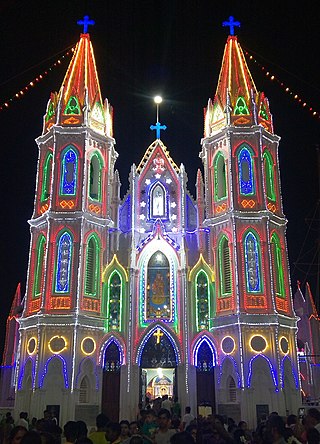
Velankanni (Vēḷāṅkaṇṇi), is a Special Grade Panchayat Town in Nagapattinam district in the Indian state of Tamil Nadu. It lies on the Coromandel Coast of the Bay of Bengal, 350 km south of Chennai (Madras), 12 km south of Nagapattinam, and 33 km southeast of Thiruvarur.
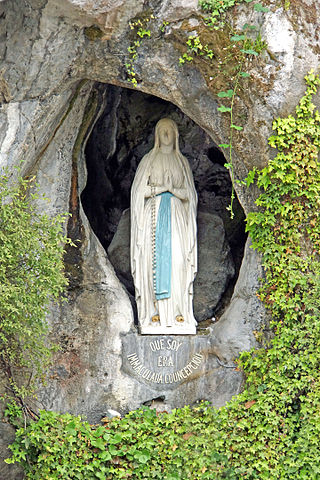
Our Lady of Lourdes is a title of the Virgin Mary. She is venerated under this title by the Roman Catholic Church due to her apparitions that occurred in Lourdes, France. The first apparition of 11 February 1858, of which Bernadette Soubirous told her mother that a "Lady" spoke to her in the cave of Massabielle while she was gathering firewood with her sister and a friend. Similar apparitions of the "Lady" were reported on 18 occasions that year, until the climax revelation in which she introduced herself as: "I am the Immaculate Conception". On 18 January 1862, the local Bishop of Tarbes Bertrand-Sévère Laurence endorsed the veneration of the Blessed Virgin Mary in Lourdes.

San Thome Church, officially known as St Thomas Cathedral Basilica and National Shrine of Saint Thomas, is a minor basilica of the Catholic Church in India, at the Santhome neighbourhood of Chennai, in Tamil Nadu. The present structure dates back to 1523 AD, when it was rebuilt by the Portuguese over what they believed was the tomb of Thomas the Apostle. In 1896, it was renovated in the Madras province according to neo-Gothic designs, as was favoured by British architects in the late 19th century.

Our Lady of Good Health, also known as Our Lady of Vailankanni, is a title given to the Blessed Virgin Mary by devotees. She is said to have appeared twice in the town of Velankanni, Tamil Nadu, India, in the 16th to 17th centuries.
Our Lady often refers to:

Basilica of Our Lady of Snows, Thoothukudi, is located at Thoothukudi, Tamil Nadu, India. It is one of the Catholic pilgrimage centers in India dedicated to the Our Lady of Snows, a title given to Mother Mary. The Shrine name refers to the Basilica di Santa Maria Maggiore in Rome. The site is known for Portuguese architecture and Portuguese prayers and now it is recognised as a Tamil Nadu notable pilgrim site.
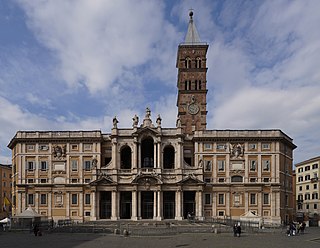
Catholic Marian churches are religious buildings dedicated to the veneration of the Blessed Virgin Mary. These churches were built throughout the history of the Catholic Church, and today they can be found on every continent including Antarctica. The history of Marian church architecture tells the unfolding story of the development of Catholic Mariology.
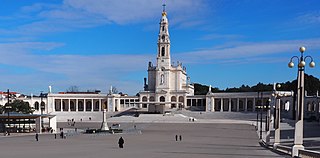
The Sanctuary of Fátima, officially titled Sanctuary of Our Lady of the Rosary of Fátima, is a Marian shrine dedicated to Our Lady of Fatima located in Fátima, in the municipality of Ourém, in Portugal. It consists of a group of Catholic religious buildings and structures with the Basilica of Our Lady of the Rosary as the main building.

Christianity in the state of Tamil Nadu, India is the second largest religion in the state. According to tradition, St. Thomas, one of the twelve apostles, landed in Malabar Coast in AD 52. In the colonial age many Portuguese, Dutch, British and Italian Christians came to Tamil Nadu. Priests accompanied them not only to minister the colonisers but also to spread the Christian faith among the non-Christians in Tamil Nadu. Currently, Christians are a minority community comprising 6% of the total population. Christians are mainly concentrated in the southern districts of Tamil Nadu - Kanyakumari, Thoothukudi and Tirunelveli.

Korattymuthy at Koratty Church is the locally known name of Hail Mary or Mother Mary of Syro-Malabar Catholic community at Koratty in Kerala State, India. Korattymuthy's Shrine is famous for its annual feast with 'Poovankula', Muttilizhayal offerings.
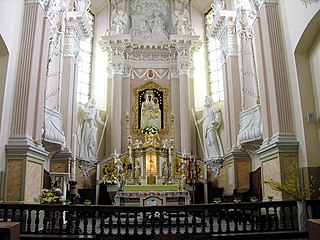
Our Lady of Šiluva is Roman Catholic image of the Blessed Virgin Mary venerated at the Basilica of the Nativity of the Blessed Virgin Mary, Šiluva shrine in Lithuania. The patriotic icon is highly venerated in Lithuania and is often called Lithuania's greatest treasure.
Religion and spirituality, a pilgrimage is a long journey or search of great moral significance. Sometimes, it is a journey to a sacred place or shrine of importance to a person's beliefs and faith. Members of every major religion participate in pilgrimages. A person who makes such a journey is called a pilgrim.
Gabriel Lawrence Sengol was the Catholic bishop of the Roman Catholic Diocese of Tiruchirapalli in India.

Pattumala Matha Church is a Roman Catholic Latin Rite pilgrim shrine in Kerala dedicated to Our Lady of Good Health. It is served by the Congregation of the Missionary Brothers of Saint Francis of Assisi (CMSF). This church is having the largest Dome among christian churches in India.

Shrine of St. Sebastian is a church in the town of Papanasam in the Thanjavur district of Tamil Nadu, India. It was constructed as a mud church in about 1870 by Fr. Abraham, the parish priest of Thiruvaiyaru. It was renovated by Abraham's successor Gabriel Playoust and consecrated on 20 January 1894. The church is known for the car festival during Easter. The church is a part of the diocese of Kumbakonam. It was bifurcated from the parish of Ayyampettai. Rev. Fr. Cyrian Kappen was the first parish priest. It started functioning as an independent parish from 1933 February 11 onwards.
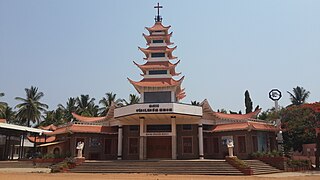
The Basilica of Our Lady of Health located in Harihar in India is a pilgrimage centre dedicated to Our Lady of Health.
Our Lady of Good Health is a title given to the Blessed Virgin Mary and an apparition of Mary in India.




